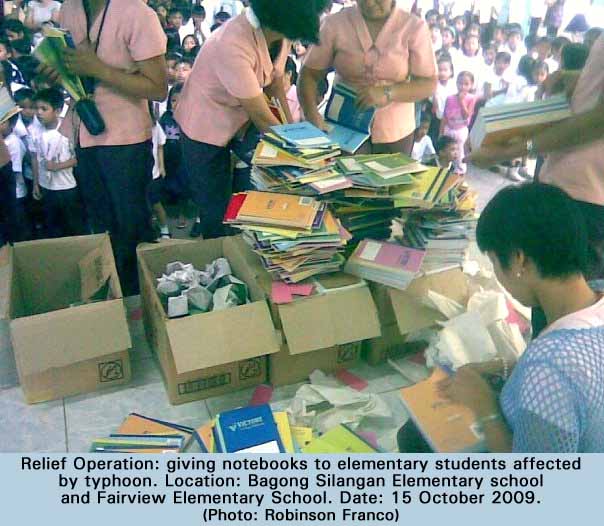DONATIONS STILL WELCOME – HERE’S OUR REPORT
I told you how it all started: finding mothers and kids drying notebooks under the sun. Then the school principals told me how countless of their pupils came to school without notebooks and pencils. Teachers had to give anything they had; but they were also victims of the floods.
Let me now report to you how we did it. The idea is simply to show how all of us can do it and the lessons that may be shared in making sure the donations reach the recipients.
First, I went directly to the affected area and checked the situation myself. I saw the school principals and asked about who are most needing help - those hit by the floods worst; not everyone of course was affected. I counterchecked their reports with the data of the barangay - which areas got submerged. In one school, the teachers, without my asking, gave me a list of students per class whose homes really got submerged and who lost almost everything.
Second, from the verified data, we then prioritized the most deserving of help. I asked the school principals to prioritize: “Yun pong walang-wala lamang o mahihirapang makabangon agad.” (This is for those who have nothing or those who will find it difficult to immediately recover.) This was because we have limited donations and not everybody could be accommodated. To this the teachers happily agreed and organized the classes themselves.
Third, we centralized the collection of donations so we can buy in bulk and therefore bargain for the lowest price and the greatest number of notebooks in the wholesale stores. This could be wiser than donors individually buying and bringing the goods to the schools. Separately doing it could tend to lose track of the priority pupils and equity in distribution. Of course it can also be done that way. But we wanted it systematic in terms of cost and priorities.
Fourth, we need to have a simple and efficient organization: the least cost in terms of personnel, time, transportation and miscellaneous expense.
Fifth, before the team was organized, organizational requirements were already set up: 1) visit to the affected school and agreements with the school authorities; 2) list of most urgent needs; 3) donations and continuing sourcing; 4) wholesale stores and addresses; 5) borrowed van; 6) briefing and conduct; and 7) email/mobile phone/money sending facility (no more office or drop off station costly to maintain).
Sixth, everything has to be documented for the information of the donors.
Lastly, no politicians around, no middlemen, no bureaucratic processes. We solicit, coordinate and deliver direct to the recipients.
So far, we have collected 22,800 pesos and delivered 4000 notebooks, 800 of which will be delivered to Aringay La Union. We are still soliciting donations for the same schools and for other schools. Any amount will do — you can email me privately and make arrangements thru money sending facilities, or call/text me 0917-894-0125.
Many thanks and blessings to all of you!
Sincerely yours,
Ferdie

Related articles:
 Home | Aims and Objectives of Solidarity Philippines Australia Network | About Kasama
Home | Aims and Objectives of Solidarity Philippines Australia Network | About Kasama 
Search the SPAN Web